
|
| Illustration: Emily Underwood |
A million meteoroids bombard Earth every second. Chris Palmer assesses whether satellites are at risk. Illustrated by Emily Underwood and Haruko Hirukawa.
Aboard NASA’s famed “Vomit Comet” — a modified 727 with all the seats ripped out — Stanford University graduate student Nicolas Lee folds a one-meter-square sheet of Mylar plastic. Lee, an origami whiz, twists the Mylar sheet and wraps it like a giant ribbon around a spool. He then gently crams the whole thing into a CubeSat, a microsatellite slightly bigger than a Rubik’s Cube.
Flying a series of parabolic arcs, the plane peaks at 32,000 feet and begins a 20-second freefall descent. Lee gives the CubeSat a slight rotation as he tosses it into the weightless environment. When the cube’s hinges swing open after a second, the Mylar canopy pops out and floats elegantly in place.
Three dozen successful attempts later, Lee is convinced the CubeSat is ready for its mission: orbiting Earth as a bull’s-eye target for incoming meteoroids.
Meteoroids were once dismissed as relatively harmless. But these high-speed, microscopic chunks of ice and rock shed by passing comets and asteroids are suspects in two multimillion-dollar hit-and-run collisions with satellites. A Stanford professor theorizes that meteoroids can vaporize into balls of electrically charged gas when they crash into a satellite at 40 miles per second. That plasma could fry the delicate circuits at a satellite’s core. “It would essentially behave like a small lightning bolt in space,” says aerospace engineer Sigrid Close.
Close’s CubeSat should set off many such bolts. By studying those emissions, Close and her team hope to collaborate with NASA and commercial satellite operators to show that the destructive capacity of the diminutive saboteurs is perhaps on par with that of space junk — larger bits of broken spacecraft and debris trapped in orbit around Earth.
More than 3,000 satellites now orbit Earth, with 1,000 more to follow within a decade. We count on these space-age servants to navigate our cars with GPS, beam global soccer games into our living rooms, and track hurricanes that threaten our shores. Some agencies that operate satellites have been reluctant to acknowledge the dangers posed by meteoroids. But more failures — and better data from scientists — may spark changes in how industry builds and flies its expensive payloads.
Rise of the space junk
One of the worst space accidents on record made the orbits above Earth much more cluttered. Cosmos 2251, a defunct Russian satellite, and a U.S. Iridium telecommunications satellite slammed into each other in 2009. The collision splintered the satellites into thousands of pieces. It will take decades for the debris to drift downward and burn up in the atmosphere. Meanwhile, each piece threatens to wipe out another satellite.
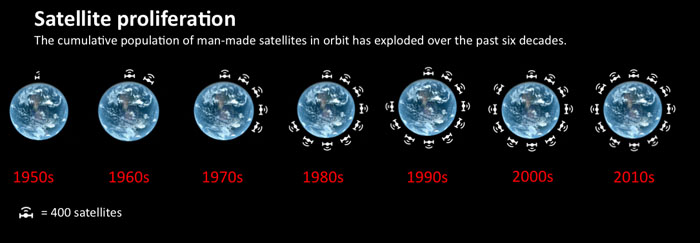 |
Graphic:
Chris Palmer |
In less spectacular fashion, space junk — everything from paint flecks to lost astronaut wrenches to spent rocket boosters — has collected in orbit at an accelerating pace since the Soviets launched Sputnik-1 in 1957. About 20,000 pieces of debris bigger than a baseball — and capable of shattering a satellite — now litter the protective cocoon around Earth. Perhaps 10 million smaller bits could damage satellites, but we have no way to track them.
Even before the Iridium-Cosmos crash, scientists feared space junk had reached a threshold where it will continue to collide with itself and operational satellites, triggering a cascading chain of collisions. Common orbits around Earth could become so jammed with junk that no company will insure launching satellites.
NASA is keenly aware of this hazard. The space agency has tracked the big destructive pieces for decades, issuing daily alerts to its centers and the satellite industry. However, meteoroids may wreak just as much havoc on satellites and spacecraft as manmade objects — and they plow into Earth, mostly unseen, 100 billion times per day.
Cosmic origins
Most meteoroids escape from decaying comets as they loop around the sun. “Think of a muddy dog running in a circle,” says Lee. “It’s just splattering everywhere.” A smaller number come from collisions between asteroids. Rarer still are meteoroids expelled from Mars and the moon by asteroid and comet impacts.
People see meteoroids only when they vaporize upon skidding into Earth’s atmosphere. Those larger than a grain of sand produce familiar streaks of light across the sky, the “shooting stars” more accurately called meteors. Bigger ones that strike the ground are meteorites.
Because meteoroids move incredibly fast, even tiny ones can pack a wallop. “It’s impossible to tell the difference between a satellite’s collision with a large piece of relatively slow-moving space debris and a collision with a small, but speedy, meteoroid,” says Close.
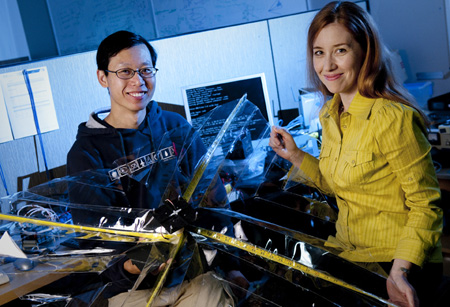
Photo: Linda A. Cicero/Stanford University News Service |
Stanford University graduate student Nicolas Lee and aerospace engineer Sigrid Close hold a prototype of their CubeSat canopy, designed to detect meteoroid impacts in orbit. |
|
|
She should know. She has spent her career — including a two-year stint manning a space surveillance telescope on a tiny Pacific island — studying the dangers to satellites. The usual suspects were space junk, lightning and solar flares — among the many topics she’s brought to the public’s attention as co-host of the National Geographic Channel show, "Known Universe." Her interest in meteoroids arose when she realized the radar systems she used to track space debris were disrupted by the ionosphere’s constant bombardment by the tiny space rocks.
Most meteoroids impacting Earth, the “sporadic population,” come from all parts of the sky. Earth also gets peppered with concentrated bursts during annual meteor showers, like the Perseids every August. These streams delight skywatchers when Earth passes through the debris-laden orbit of a comet.
NASA takes special precautions during the known showers. The space agency delays launches and re-orients satellites and spacecraft so the big, bulky parts are not smack in the path of the oncoming stream. The most common maneuver is rotating solar panels.
Even before the out-of-nowhere explosion of a bus-sized meteor over Russia’s Ural Mountains in February 2013, policymakers had become concerned about the threat of meteoroids. In 2011, the National Academy of Sciences commissioned a report to assess the collision hazards posed to spacecraft by meteoroids and space debris. Close and University of Western Ontario astronomer Peter Brown wrote the chapter about meteoroids. “There is strong evidence for some satellites having been operationally affected and some missions being terminated as a result of meteoroid impacts,” Brown says.
Although they are dangerous, meteoroids are widely spaced. “Even in a meteor shower you may only have one meteor per square mile,” says Bill Cooke, director of NASA’s Meteoroid Environment Office in Huntsville, Alabama. “It’s not at all like it’s depicted in the movies. The only reason we worry about it is we have so many spacecraft up there.”
Once every few decades, a rare phenomenon called a meteor storm dramatically increases the chance of a collision. Storms occur when Earth passes through a dense ribbon in a comet’s debris trail. During one such outburst two decades ago, the first satellite thought to be a victim of a meteoroid spun out of control.
Lightning bolt in space
In 1992, the parent comet of the Perseid shower, 109p/Swift-Tuttle, was discovered as it approached Earth. Astronomers predicted a meteor storm for the following summer. Though the shower fell short of a storm, a European telecommunications satellite, Olympus 1, suffered electrical problems during the shower’s peak. Olympus lost its pointing ability, nearly burning up its remaining fuel righting itself. Operators ended the satellite’s mission and moved it into a graveyard orbit, away from working satellites.
At first, experts blamed space debris. A Perseid speck seemed like a negligible risk. “If you think of a nano-sized particle, you can’t see it,” says Close. “So, it’s hard to imagine that could take out a billion-dollar satellite.”
It’s also hard to prove what happened. “The spacecraft themselves don’t have enough self-diagnostics, so we often don’t really know what went wrong,” says Boston University astronomer Meers Oppenheim, a meteoroid expert.
For Olympus, evidence pointed toward a fatal meteoroid collision that sparked electrical damage, not mechanical problems. The satellite’s trajectory never shifted, meaning it was not hit hard. Also, operators regained control of the satellite long enough to move it to another orbit — consistent with an electrical glitch that subsided.
When meteoroids rifle into Earth’s atmosphere, they vaporize into balls of plasma — charged clouds of protons, neutrons and electrons. Impacts with satellites can set off brief plasma bursts. In slow motion, the plume would resemble a spark or a tiny lightning bolt. This happens every day, and it’s usually not a problem. However, any spark can bridge parts of a satellite that should be electrically isolated from one another.
Such a fate may have struck the joint connecting Olympus to its solar array. That array probably was highly charged due to its exposure to the sun. Current would have flowed from the array into the satellite via a plasma bridge, frying the electronics. A European Space Agency investigation listed a meteoroid-generated plasma as one of several possible mechanisms—the first broad realization that meteoroids could cause that type of damage.
Some spacecraft designers doubt this scenario. “We are aware of once in recorded history where people suspected that’s what happened, although they weren’t able to prove it,” says Chris Hoeber, senior vice president of systems engineering at Space Systems/Loral. Tim Deaver, vice president of government and institutions development for the satellite manufacturer SES, concedes plasma emissions could cause some anomalies on satellites. However, he says, “They don’t happen frequently, maybe every five years. . . . Most people don’t consider [meteoroids] a threat, because the volume in space is just so large.”
But NASA's Cooke is convinced that a meteoroid felled Olympus. In the past decade, investigations into nearly a dozen other satellite failures have pinned the cause on similar plasma-related mishaps. The clearest example is Landsat-5, which spun out of control during a Perseid shower in 2009. Landsat resumed its mission of snapping high-resolution pictures of Earth after its operators stabilized the satellite.
Close believes the electronics aboard such satellites may get knocked out not by electrostatic sparks, but by radiating electromagnetic pulses, or EMPs, created by the plasma. When a high-velocity collision occurs, electrons radiate outward. If enough do so at the same time, they create an EMP. A similar phenomenon on a much larger scale accompanies a nuclear blast.
“If you slam a particle going 50 kilometers [30 miles] per second into a piece of metal, that’s a lot of energy. It’s over 10 times faster than a speeding bullet,” says Oppenheim. “It will certainly generate an EMP.”
The pulse can seep into a satellite and zap internal components. “Once you make an electromagnetic wave and it gets into the spacecraft,” says Close, “it’s a much more nefarious type of failure than just a discharge.”
Radio-free orbit
To test whether plasma from meteoroid collisions could produce radio frequency (RF) emissions capable of penetrating satellites, Close chose a venue that mimics space: a hot-tub-sized vacuum chamber in a Van de Graaff accelerator at the Max Planck Institute for Nuclear Physics in Heidelberg, Germany.
Nicolas Lee and Close’s other students used the accelerator to blast small iron particles into palm-sized mockups of solar panels donated by Lockheed Martin. Sensors in the vacuum chamber detected puffs of plasma followed by sharp RF pulses lasting a few microseconds. At least in theory, plasma could create a rogue RF wave in space.
Scientists debate whether such a wave is powerful enough to fry a satellite. “An EMP can destroy a spacecraft if it reaches a sufficient magnitude,” says Oppenheim. Brown is more skeptical, but he concedes: “If it happens to be near some delicate electronics, it doesn’t have to be a gigantic lightning bolt. It can be very small and localized and still be destructive.”
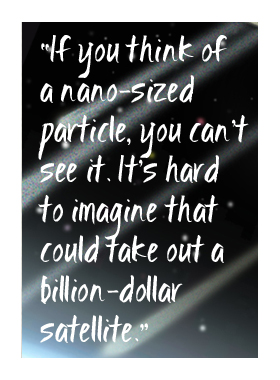 Justin Likar, an engineer in the spacecraft survivability group at Lockheed Martin Space Systems, sees promise in Close’s results. “The challenge lies in taking the RF signatures that have been detected in the lab and demonstrating that there is a real susceptibility [to satellites],” he says. Justin Likar, an engineer in the spacecraft survivability group at Lockheed Martin Space Systems, sees promise in Close’s results. “The challenge lies in taking the RF signatures that have been detected in the lab and demonstrating that there is a real susceptibility [to satellites],” he says.
Close’s next step is to send the experiment to space. She has funding from NASA to build miniature plasma detectors to ride aboard the Mylar canopy CubeSat — a prototype of which Lee tested in NASA’s Vomit Comet. The CubeSat should be ready to launch by 2015, Close says. In orbit, the canopy will unfold and telescope out along four booms, providing a target the size of a card table for incoming meteoroids. “It’s like trying to wave a flag out there to get hit by more stuff,” says Lee.
Close expects no more than one strike per day. But that should be enough to determine how often EMPs and electrostatic discharges occur and how powerful they are.
The results could be influential, says Oppenheim. “If we want to have billions of dollars’ worth of spacecraft up there, we really have to know the environment in gruesome detail,” he says. “We need to know what’s going on and why, so we can engineer the devices to make them robust.”
Likar adds, “[Close] is performing important work to understand the complex manner in which meteoroids may interact with operating spacecraft. Folks on the design and manufacturing side have to do their homework in understanding her results and identifying possible operational and design susceptibilities.”
Most people in the satellite industry aren't yet worried. Manufacturers already build in defenses against solar radiation, says Hoeber of Space Systems/Loral — and those defenses should protect against meteoroids as well. “We don’t redesign our spacecraft specifically to mitigate meteoroid damage,” he states.
That view, Close says, ignores the distinction between damage caused by electric discharges and damage caused by EMPs, which satellites are not designed to thwart. “I would agree that EMPs are small and short-lived, and that’s why there haven’t been satellites just falling out of space,” she says. “However, every satellite gets hit once a day. Once a year, something fails. And I would argue that once a month, something happens that’s anomalous.”
Close’s research suggests ways to design satellites more robustly. For instance, keeping vital components separated will lower the chance for plasma bridges to fry anything critical. Heavier shielding is another option; Close calculates that meteoroid-sparked EMPs can be 100,000 times larger than current shielding can withstand.
But every pound launched into space can cost an extra $10,000. Beefing up satellite defenses against meteoroids will require an iron-clad case, Close realizes. Until then, the orbital onslaught will continue — and no one will know the true cost.
Sidebar: Cubes on Space Patrol
In August 2012, a CubeSat lofted into low Earth orbit. The inexpensive telescope, composed of three stackable Rubik’s Cube–sized boxes, was built by engineers at Lawrence Livermore National Laboratory (LLNL) and the Naval Postgraduate School in Monterey. Their goal is to improve predictions of space-junk collisions — not just by a little, but by a factor of 100.
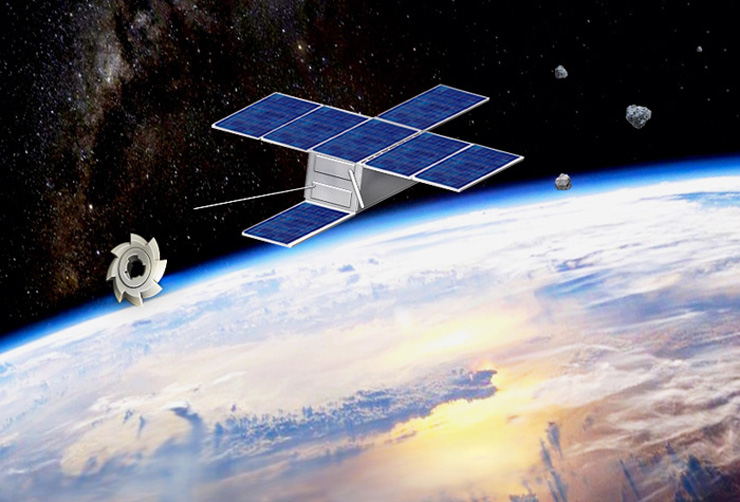
Illustration: Haruko Hirukawa |
|
|
A global network of more than two dozen optical telescopes and radar stations on the ground keeps tabs on every satellite and spacecraft in orbit. The system also tracks 20,000 pieces of space debris bigger than baseballs. Every day, the U.S. Joint Space Operations Center issues alerts about potential collisions to space agencies and satellite operators. However, trajectories of orbiting objects are hard to predict. Often they’re accurate only to within a half-mile or so. Operators know that 9,999 out of 10,000 collision warnings are false alarms. Most are ignored. In hospitals, they call this “alarm fatigue.”
“We want to lower the alarm notification from once per month to once per lifetime of the satellite,” says lead project scientist Vincent Riot of LLNL. “These satellites only have so much fuel onboard, and you don’t want to waste it” by moving them unless it’s essential.
The miniature CubeSat observatory has two cameras. One takes pictures of stars to figure out the CubeSat’s position and orientation. The other snaps pictures of space junk to predict their trajectories. There's always dark sky in orbit, so the telescope can spot junk all the time. Also, CubeSats orbit Earth quickly, so they can observe single objects several times each day. More observations lead to better predictions about whether a particular satellite is in harm’s way.
Riot and his colleagues think a constellation of 18 such CubeSats, costing $30 million total, could survey the entire sky. Even though each CubeSat will last just a year or two, the cost of replacing the microsatellites is dwarfed by the price tag for most conventional satellites: several hundred million dollars.
Story ©2013 by Chris Palmer. For reproduction requests, contact the Science Communication Program office.
Top
Biographies
 Chris Palmer Chris Palmer
B.S. (psychology and biology) Northern Arizona University
Ph.D. (neuroscience) University of Texas at Austin
Internships: The Scientist, National Cancer Institute (2013-14 fellowship)
I studied neuroscience to learn who we are and what makes us tick. Probing the properties of neurons—first in the visual cortex of primates, and then in the motor system of leeches—was supposed to yield deep insights into the biological origins of perception, emotion, even thought itself. Unfortunately, the biggest insight from my years as a scientist is that I am miserable behind a microscope.
Doing research did satisfy my obsessiveness and creativity; I wrote endless iterations of computer code and designed intricate leech obstacle courses. But as a postdoc, I found new outlets by writing review papers and editing manuscripts. This inspired me to write about the cornucopia of science at UC San Diego. Now my days are consumed by covering the discoveries and controversies that make science so intriguing.
Chris Palmer web site
. . . . . . . . . . . . . . . . . . . . . . . . . . . . . . . . . . . . . . . . . . . . . . . . . . .
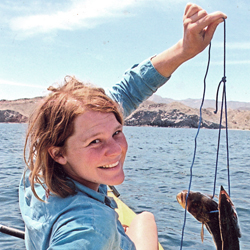 Emily Underwood Emily Underwood
B.S. (Earth sciences) University of California, Santa Cruz
M.S. (geology) Oregon State University, Corvallis
Internship: Bay Nature Magazine
I am a native Californian with a fascination for the natural world and a passion for art. I have spent a lot of time exploring the landscapes and learning about plants, animals, soils, rocks, weather, rivers, coastlines, deserts, and mountains. I love to share my understanding and enthusiasm with others through art. I am currently writing and illustrating a book about reading the landscapes of California.
Emily Underwood web site
. . . . . . . . . . . . . . . . . . . . . . . . . . . . . . . . . . . . . . . . . . . . . . . . . . .
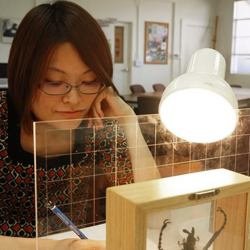 Haruko Hirukawa Haruko Hirukawa
B.S. (agriculture) Utsunomiya University, Japan
M.S. (integrated biosciences) The University of Tokyo
Internship: Institute of Transformative Bio-Molecules (ITbM), Japan
Haruko Hirukawa has an academic background in molecular biology and media arts. Her interest in science and art began at an early age; she has always been thinking about how she can combine her interests. She hopes to encourage science activity and stimulate science community through her art work as much as she can.
Haruko Hirukawa web site
Top |

